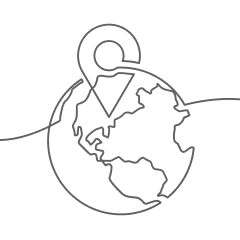You want to build a web application, but you’re worried about the cost? With research showing that 45% of software projects end up over budget, it’s understandable to be concerned. But with the right software development estimation template, you can have a clear picture of the required budget and timeline for your web application project.
In this article, we’ll provide a ballpark estimate of the costs involved in web application development and a handy estimation template to help you get started. Our goal is to help you create a comprehensive and accurate budget that will ensure the success of your project.
We understand that budgeting for a web application development project can be a tricky process, and there are many variables to consider. To help you get started, we’ll review the typical cost components, from development and design to hosting and maintenance. We’ll also provide tips on lowering the costs.
Are you ready to start planning your web application development budget? Let’s begin!
Web application development costs
The cost of developing a web application depends on its scope and complexity, among other factors such as your developers’ location and your tech stack. Web application development can cost anywhere from $3,000 for a simple web app with a small set of features to $100K+ for a custom, complex enterprise web application.
As a general rule, simpler web applications will be cheaper than complex ones. Applications that have simple UIs and minimal data processing and no third-party integration requirements will be less expensive to build, whereas applications with heavy user loads, complex UIs, and external system integrations will cost more.
The best way to estimate your own web application development cost?
- Start by reviewing the development cost factors below. Consider your own project’s requirements to get a sense for the cost range you should expect.
- When you’re ready to get a more precise estimate, consult with development companies who are experienced in web app development. Provide them your project requirements and request a quote.
With this in mind, let’s take a look at the key factors that affect the web application development cost.
Web application development cost factors
A range of factors can contribute to the cost of web app development, including the scope of research and planning required, your technology choices, complexity of the software project, UI/UX requirements, the hiring model you choose, as well as the location and experience of the vendor you decide to work with.
Whether you’re handling web app development in-house or working with an outsourcing company, you should be aware of how each of these factors can affect the development costs. So, let’s dive in!
Research and planning

Let’s start by talking about something that comes before any web developers write a single line of code: research and planning. This is one of those cost categories that can sneak up on teams during the web application development process.
Regardless of the complexity of your web app, you will need to do some level of research to help you define exactly what it is you want to build and how you want to build it. While every web development project will require some level of research and planning, the scope of work can vary significantly.
The more in-depth and comprehensive the research and planning phase is, the more expensive it will be. Consider if your web app development project will necessitate any or all of the following:
Competitor analysis: This analysis involves researching the current and potential competitors, their products features and technology they are using. This analysis is used to inform the strategy and approach of your own web app project and determine how the web app should be positioned against competitors in the market.
Requirements gathering: Requirements gathering is an important part of the research and planning phase, as it helps to define the scope and goals of the project. This involves working with stakeholders to identify their needs and objectives, and then creating a plan that meets those needs and objectives. This can be a lengthy process, as stakeholders may have varying opinions about what their needs are, and it can be costly if it takes a long time to reach agreement.
Tech solutions research: After you have an idea of what your web app will look like, you will need to find suitable technologies to implement your plans. This is an important step of the web app development process, as it helps to ensure that the project will be built using the most appropriate and cost-effective technology.
Next steps:
- Draft Software Requirements Specification document to outline all requirements for your web app.
- Decide if you will be handling the research and planning work internally or if you will work with a software development vendor who can help you. This can affect the cost for this work.
Technology choices

Technology choices can certainly affect your web app development cost. When considering various technologies, web app developers must take into account the long-term costs associated with maintaining the technology, as well as the cost of training staff to use the technology.
Choosing an open-source technology can be an effective way to reduce upfront costs, but the cost of maintenance must be taken into consideration as well. Similarly, choosing an off-the-shelf technology can reduce development time, but the license costs should be taken into account.
Ultimately, technology choices should be made based on the long-term costs associated with the web app project, as well as the specific needs of the project.
Technology stack. The selection of a tech stack is an important factor in the cost of a development project, as the technologies chosen should be able to satisfy the requirements of the web app and provide the most cost-effective long-term solution. For example, an open-source technology stack such as Django is less expensive than a proprietary stack such as Microsoft.NET.
Deployment requirements. The deployment requirements also play an important role in the cost of web app development, as hosting costs can vary greatly depending on the infrastructure, bandwidth, and other requirements. For example, deploying web apps to a PaaS hosting environment like Heroku may be less costly than deploying them to a dedicated server.
Level of customization of 3rd party tools. Customizing existing tools can be expensive, as the development team will need to invest time and energy into making the tools fit the specific needs of the project. It is important to weigh the cost of customization against the cost of developing custom tools from scratch.
Scope of automated test coverage. Automated testing can be expensive to develop, but the cost of developing automated tests is often much lower than the cost of debugging and fixing bugs in a system. Automated tests can also provide a faster feedback loop, which can help speed up development cycles and reduce overall project costs.
Next steps:
- Consult with your CTO or hire a CTO-as-a-service to get support vetting and selecting technologies for your web app.
- Build a matrix of tech stack options, comparing pros, cons, short-term costs, and long-term costs.
- Discuss specific technology requirements with a few software development vendors to get an idea of the costs required to build to your specifications.
Complexity of the project

It may seem obvious, but the cost of developing a web app is closely related to its complexity. Complex web apps require more time and resources to develop, as they involve more intricate coding, more complicated testing, more robust security, and more complex user interface design. This can result in a significantly longer development cycle and higher costs.
To help gauge the complexity of your own project, consider three main factors that impact web app development complexity:
Number of screens. The number of screens of an app can significantly affect the cost to develop. The more screens a web app has, the more time is needed to design and develop the layout of each page, as well as the functionality of each page. In addition, more screens can lead to a more complex code base, which can require more time to debug.
Complexity of screens. Web apps that require screens with large data tables will have increased UI design costs as these types of screens are much more complex to build than standard ones.
Functional requirements. An increase in the number of functional requirements will increase the complexity of the web app development. Each feature or functionality requirement has to be taken into consideration when determining the scope and cost of a project. And - don’t forget to give yourself some buffer in case requirements are added after the web app developers have started work.
Non-functional requirements. In addition to functional requirements, requirements for things such as regulatory compliance, security, reliability and performance can also affect the web app development cost.
Next steps:
- Work with a UI/UX design team to scope out the number and complexity of the screens required for your web app.
- Revisit your requirements list, and adjust your software estimates according to any changes you have made. As your list becomes more precise, your web application development cost estimate will become more accurate.
UI/UX requirements

UI/UX requirements can have a significant impact on the web app development cost. The amount of work and resources that go into web design - both the user interface (UI) and user experience (UX) - can be significant. You should ensure you are properly scoping this out if you want to have an accurate web development cost estimate.
The scope of UI/UX work can vary significantly, and may include things such as:
User research. An essential step to understanding the target users and their needs, user research can provide the web development team insights into user behavior, preferences, and requirements, which can then be used to inform the design and development process.
User personas. A user persona is a semi-fictional representation of a user based on the data gathered during user research. It helps to identify user goals and needs, which can then be used to inform the design process.
User journey maps. A user journey map is a visual representation of a user's experience with a product or service. It helps to identify areas that need improvement and opportunities to provide a better user experience within a web app.
User stories. User stories are brief summaries of how a user interacts with the product or service. They are an important part of the development process, as they provide a clear understanding of the requirements and expectations of the users.
Wireframes. Wireframes are used to visualize the design and allow for iteration and feedback. Building wireframes can be costly, depending on the complexity of the product, who you hire to build them, and the tools that are used to build them.
Clickable prototypes. Creating a clickable prototype is often necessary in order to check for usability and user experience issues. Prototypes can be expensive to create, as it requires specialized software and expertise.
Recommended next steps:
- Develop user stories to flesh out your functional requirements. This will help you improve the accuracy of your web app cost estimate.
- Work with a UI/UX team to create low-fidelity wireframes or sketch out your own low-fidelity mockups to document your web app’s screens and core functionality.
- Work with a UI/UX team to create a high-fidelity UI prototype to ensure your project scope is sufficient to meet end-user needs.
Hiring model

Consider who will be supporting the development of your web application. Will you be working with an in-house team, freelance developers you hire and manage, or perhaps a full-service web app development team hired through an outsourcing company? The hiring model you choose will affect the web application cost.
In most cases you have three options:
In-house software developers. Web applications developed by in-house teams will require a larger initial investment in the form of salaries and benefits for developers and your project manager, as well as other overhead costs such as office space and equipment. However, the advantage is that the developers are directly managed and monitored by you, ensuring that the project is completed to your specific standards. Additionally, the web application developers can be easily integrated into the existing organizational structure and culture.
Freelance software developers. Hiring freelancers has become increasingly popular in recent years, as it offers growing companies a cost-effective, flexible option for web application development. You won’t have to worry about salaries and benefits or other overhead. However, it can be difficult to predict the quality of work you will receive, and you will be responsible for project management.
Outsourcing development company. Especially for large-scale or complex projects, working with a full-service web development company is a good option, as it allows you to tap into a larger pool of developers, which can often result in cost savings. Additionally, a web app development company can bring experience in the specific technologies and platforms used in the project, which can result in greater efficiency and a higher quality web app.
Next steps:
Reach out to freelancers and custom web development companies to request quotes for your web app project. Compare the costs to those of handling development internally.
Learn more how to choose the best web application development company and start making a list of potential companies you are interested in working with.
Vendor location

If you’re outsourcing your development project, you should consider the location of the web development company or freelancers you hire. The location of your developers can dramatically impact the rates you pay. Generally, we can divide web developer locations into four categories:
Asia/India (rates: $25-40/hr) Hiring from Asia or India tends to be the cheapest option for finding web app development companies. However, you may find the cultural differences, time zones, and development quality may not meet your needs.
Eastern Europe (rates: $25-40/hr) Eastern Europe has become a popular region for web development services due to its relatively low labor costs and access to a large pool of highly-skilled frontend and backend developers. Countries such as Poland, Ukraine, and Romania are becoming increasingly popular for technology companies looking to reduce their software development cost.
Why do companies outsource to Eastern Europe?
- Highly-skilled, growing IT workforce
- Cost-effective developer rates compared to Western Europe and the US
- Strong English language proficiency and cultural affinity
- Convenient time zone overlap for US clients
Western Europe (rates: $60-80/hr) Generally, Western Europe is more expensive than Eastern Europe due to higher labor costs. However, countries such as the UK, Germany, and France have access to a large pool of highly-skilled developers, which may be the right option for some.
US (rates: $80-100+/hr) The United States is one of the most expensive places in the world for software development due to high labor costs. However, the US has access to a wide range of development tools and a large pool of highly-skilled software developers.
Next steps:
Assess your specific priorities for development teams or freelancers, and decide which location or locations are the best fit. If you are considering two geographical locations, compare specific developer rates for the work you require for your web app.
Support & maintenance

Support and maintenance can significantly impact the cost of web development. Without proper monitoring, on-call support, and technical improvements, web apps can quickly become outdated and expensive to maintain. When comparing quotes from vendors, don’t forget to consider costs that may be necessary post-launch, including:
Performance monitoring. Web apps should be reviewed regularly to ensure that they are running as expected. This could include things like checking system logs, tracking application usage, and identifying potential areas of improvement. If a system is not monitored properly, problems may go undetected and result in costly repairs or system downtime.
On-call support. Since web apps are ever-evolving, issues may arise as time passes post-launch. Having a team of technicians ready to respond to customer inquiries and provide technical assistance can help reduce the amount of time required to resolve issues.
Technical improvements. As your business grows and new technologies become available, you’ll find you want to enhance your web app. Technical improvements could also be required for things like bug fixes, security patches, or feature upgrades. Failing to keep software up-to-date can lead to security vulnerabilities and poor performance for users.
Next steps:
- Decide what level of post-launch support your web app will require and if you will staff it internally or work with a vendor.
- Ask potential vendors detailed questions to understand exactly what post-launch support is included in their quote.
Web app development cost estimation template
Ready to estimate your own web development project costs? Get a copy of the estimation template here!
Ways to save on the web app development costs
There’s no doubt about it: web application development can be expensive. If you’re leading your own web app development project, you should be looking for ways to reduce costs and improve your bottom line.
By reducing your web app development costs, you can free up resources to invest in marketing or future feature enhancements to benefit your users. This can help to increase your profits long-term. After 15 years in the industry, we’ve seen these 4 methods help companies of all sizes reduce their web development costs, all while not sacrificing quality:

Start with an MVP: Starting with a minimum viable product allows you to focus on the core features of your product and help you save money on the web app development cost. By focusing on the essential features, you can avoid spending money on unnecessary development costs while still having a useful product.
Lock the UI before development: Locking the UI before development helps ensure that all stakeholders are in agreement on the design and functionality of the website before any code is written. This reduces the amount of back-and-forth revisions and eliminates the need for costly changes down the line. It’s always cheaper and faster to make changes during the design stage!
Outsource to Eastern Europe: Outsourcing to Eastern Europe is an affordable way to hire web developers who are highly skilled and experienced, while still keeping costs low. It also allows you to access a larger talent pool and access to resources that would usually be too expensive to hire locally.
Limit change requests: Limiting change requests from stakeholders throughout development can help save money by reducing the amount of time and resources needed to accommodate them. It also helps focus development efforts on the original goal, ensuring that the web app is completed on time and within budget.
Conclusion
Web application development can be expensive. It’s understandable if you are concerned about the cost. However, with the right web application cost estimate, you can have a clear picture of your project’s budget - right from the start.
By understanding the various cost components, such as development and design, hosting and maintenance, and hiring models, you can create a comprehensive and accurate budget for your project.
Additionally, there are ways to save on development costs, such as starting with an MVP, locking in the UI before development starts, and limiting change requests throughout the web application development process.
If you’re looking for a web application development company, we’d love to help. We can help you plan, design and build a web solution without the headache. Reach out to get a free quote!







